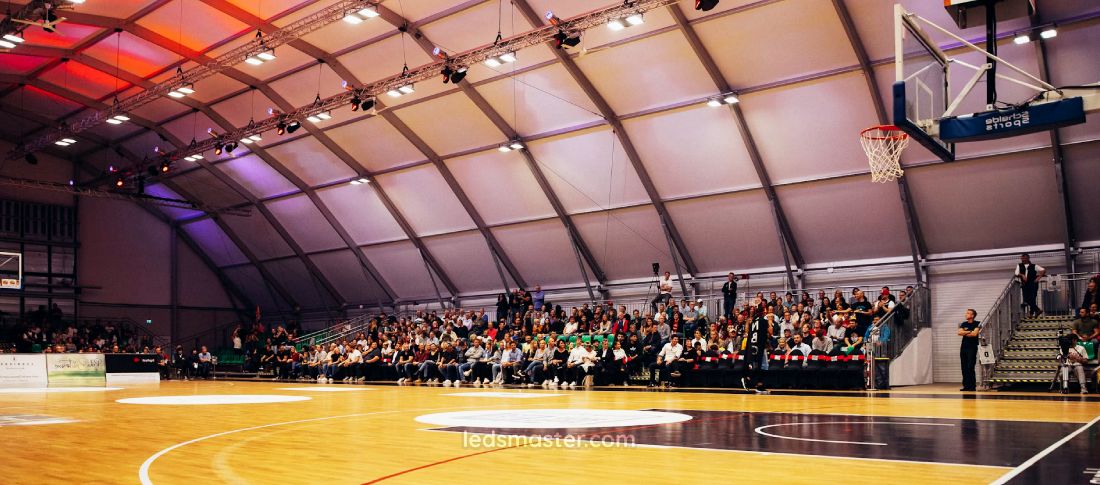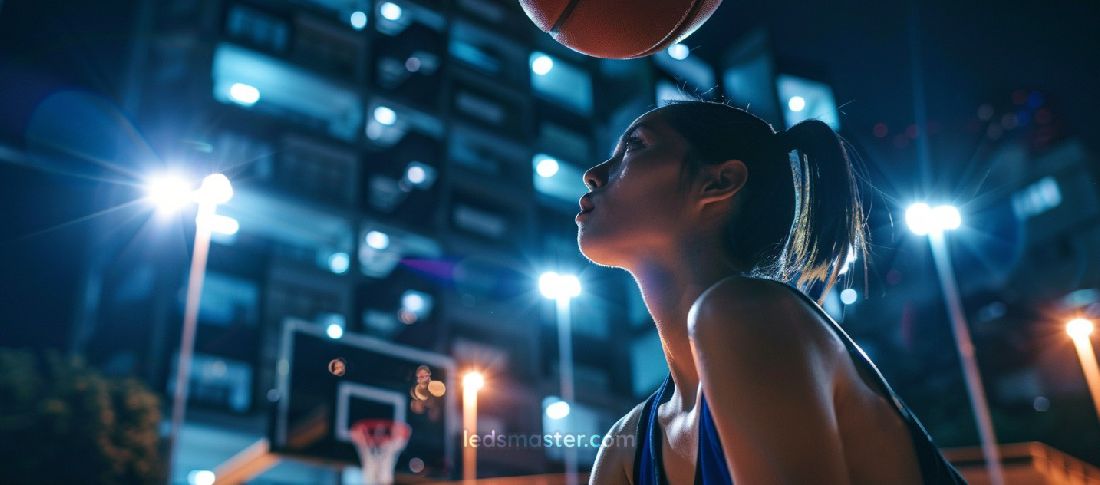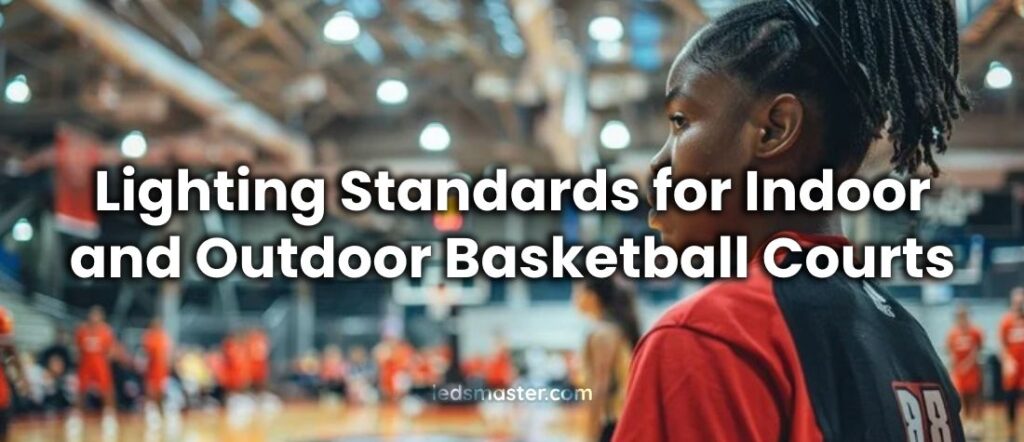Table of Contents
ToggleIntroduction
Basketball courts require precise lighting to ensure optimal performance and safety for players. LED technology has revolutionized the way indoor and outdoor courts are illuminated, offering superior efficiency, performance, and flexibility compared to traditional lighting solutions.
LED Lighting for Basketball Courts
Indoor Basketball Court
Indoor basketball courts require lighting solutions that not only illuminate the entire playing area but also enhance visibility and minimize distractions for players. Achieving uniform lighting is essential to reduce shadows and ensure that players can see clearly from every corner of the court. LED lights have emerged as the preferred choice for indoor basketball facilities due to their ability to meet these stringent requirements effectively.
LED lights provide consistent brightness across the entire court, aligning closely with the standards set by organizations like the Illuminating Engineering Society (IES). This uniform illumination helps maintain optimal playing conditions, allowing players to focus on their performance without being hindered by uneven lighting or dark spots.
One of the key advantages of LED technology is its high color rendering index (CRI), which measures how accurately colors are rendered under the light source compared to natural sunlight. A high CRI ensures that the vibrant colors of the court, jerseys, and basketball are accurately represented. This is not only aesthetically pleasing but also essential for player recognition and visual comfort during fast-paced games where split-second decisions can be critical.
Moreover, LED lights are known for their longevity and durability, significantly reducing maintenance costs and downtime for indoor facilities. They have a longer lifespan compared to traditional lighting technologies like metal halide lamps, requiring fewer replacements and ensuring consistent performance over extended periods.

Outdoor Basketball Courts
Outdoor basketball courts present unique challenges due to their exposure to natural light variations and weather conditions. These factors necessitate robust lighting solutions that can withstand outdoor environments while ensuring consistent visibility for players.
LED lighting has emerged as a superior choice for outdoor courts, offering durability and reliability that traditional lighting technologies struggle to match. LEDs are engineered to withstand harsh weather conditions such as rain, wind, and temperature fluctuations without compromising on performance. This resilience makes them ideal for outdoor settings where constant exposure to the elements is a concern.
One of the significant advantages of LED technology for outdoor courts is its ability to provide instant illumination. Unlike older technologies like metal halide lamps that require warm-up times, LEDs offer immediate light output, allowing games to start promptly after sunset or in low-light conditions. This instant illumination contributes to the safety and efficiency of outdoor basketball activities, ensuring players have clear visibility from the moment they step onto the court.
Furthermore, LEDs are highly efficient in delivering targeted light levels precisely where needed, thereby optimizing energy consumption. The Illuminating Engineering Society (IES) provides guidelines for outdoor court illumination levels, typically ranging from 50 to 200 lux. These standards take into account ambient light conditions and specific usage requirements, ensuring that the lighting is adequate for gameplay while minimizing unnecessary energy use.
Advantages of LED Technology in Basketball Lighting
Energy Efficiency and Cost Savings
LED lighting offers substantial advantages in energy efficiency and cost savings for basketball courts, both indoor and outdoor. Unlike traditional lighting sources such as incandescent or fluorescent bulbs, LEDs convert a higher percentage of electrical energy into visible light. This efficiency is measured in lumens per watt (lm/W), where LEDs typically achieve higher values than older technologies. As a result, LED lighting systems consume less electricity to produce the same amount of light, leading to significant reductions in energy bills for facilities.
For basketball courts, which often require extensive lighting during practices, games, and events, these energy savings can be substantial over time. Indoor facilities, in particular, benefit from LEDs’ ability to deliver uniform and bright illumination across the court without wasting energy on heat generation, which is common with traditional bulbs. This efficiency not only lowers operational costs but also aligns with sustainability goals by reducing the carbon footprint associated with electricity consumption.
Moreover, the longer lifespan of LED lights compared to conventional lighting technologies is another key advantage for cost savings. LEDs can last significantly longer—often tens of thousands of hours—before needing replacement. This longevity reduces the frequency of maintenance and replacement costs associated with bulb changes, labor, and downtime for court usage. Facilities managers can allocate resources more efficiently, focusing on other aspects of maintenance and improvements rather than constantly replacing bulbs.
Superior Light Quality and Performance

LED lighting stands out for its superior light quality and performance, making it an ideal choice for basketball courts. Key to this advantage is LEDs’ exceptional color rendering capabilities, characterized by a high color rendering index (CRI). The CRI of LEDs ensures that colors appear vivid and true to life, accurately representing the vibrant hues of the court, team jerseys, and the natural skin tones of players. This high fidelity in color rendering enhances visibility and contrast, crucial for players to track the ball and make split-second decisions during fast-paced games.
The clear visibility provided by LED lighting not only benefits players but also enhances the overall experience for referees and spectators. Referees rely on accurate color perception to make fair and informed calls, while spectators enjoy a more engaging viewing experience with enhanced visual clarity of the action on the court.
Additionally, LED lights deliver uniform illumination across the entire basketball court, minimizing shadows and ensuring consistent brightness levels from baseline to three-point line. This uniformity is essential for player safety and performance, as it eliminates dark spots or uneven lighting that could affect gameplay. Players can move confidently and react swiftly under consistent lighting conditions, reducing the risk of injuries and enhancing their ability to perform at their best.
Furthermore, the ability of LED lighting systems to maintain consistent brightness levels throughout their lifespan contributes to reliability during games and practices. Unlike traditional lighting technologies that may degrade in performance over time, LEDs maintain their initial light output and color quality, providing reliable illumination for extended periods without the need for frequent adjustments or replacements.
Durability and Reliability
LED lighting stands out for its exceptional durability and reliability, particularly in demanding environments like outdoor basketball courts. Unlike traditional lighting technologies, LEDs are engineered to withstand various challenges such as shock, vibration, and temperature fluctuations effectively. This robust construction ensures that LEDs maintain consistent performance and longevity, even under harsh outdoor conditions.
Outdoor basketball courts are exposed to the elements year-round, including rain, wind, and extreme temperatures. LEDs are designed to be highly resilient to moisture and can operate reliably in both hot and cold climates without compromising their lighting performance. This resistance to environmental factors reduces the risk of malfunction or damage due to weather conditions, providing continuous illumination for practices, games, and events regardless of outdoor challenges.
Moreover, the durability of LEDs translates into significant cost savings for facilities. LED lighting systems require less maintenance compared to traditional technologies, such as metal halide lamps, which often require frequent bulb replacements and repairs. The longer lifespan of LEDs means fewer disruptions and downtime for maintenance, allowing facilities to allocate resources more efficiently and minimize operational costs over time.
By reducing maintenance needs and ensuring consistent lighting performance, LEDs contribute to the overall operational efficiency of basketball courts. Facilities managers can focus on optimizing other aspects of court management and improving the player and spectator experience, rather than addressing frequent lighting issues. This reliability enhances the reliability and safety of outdoor basketball activities, ensuring that players can perform at their best under consistent and dependable lighting conditions.
Instant On/Off and Dimming Capabilities
LED lighting technology provides significant advantages in terms of instant on/off capabilities and dimming flexibility, particularly beneficial for basketball courts where precise lighting control is essential for gameplay and energy efficiency.
LEDs offer instant illumination when activated, without any warm-up time required. This immediate on/off capability ensures that basketball games can start promptly and proceed smoothly without delays caused by waiting for lights to reach full brightness. This feature is crucial for ensuring the safety of players and maintaining the pace of the game, where consistent and reliable lighting is paramount.
In addition to instant on/off functionality, LED lights can be easily dimmed and controlled to adjust lighting levels according to specific needs. For basketball facilities, this flexibility allows operators to optimize energy consumption by reducing light output during practice sessions or times of low activity. Conversely, during televised games or events requiring heightened visibility, LED lighting can be adjusted to provide optimal brightness and clarity on the court.
The ability to dim LEDs not only enhances energy efficiency by matching light output to actual usage but also contributes to the overall sustainability of the facility. By reducing unnecessary energy consumption during off-peak hours or non-game times, basketball facilities can lower their operational costs and environmental impact without compromising on lighting quality or player safety.
Moreover, LED dimming capabilities support a better viewing experience for spectators by allowing precise control over lighting levels in different areas of the court. This ensures that all parts of the arena, including seating areas and sidelines, receive adequate illumination without glare or shadows, enhancing the overall enjoyment of the game for attendees.
Environmental Benefits
LED lighting technology offers significant environmental advantages, making it a preferred choice for basketball courts and sports facilities committed to sustainability.
LEDs are highly energy-efficient, converting a larger proportion of electrical energy into visible light compared to traditional lighting sources like fluorescent or metal halide lamps. This efficiency results in reduced energy consumption, lowering the demand for electricity from power plants. By consuming less energy, LEDs contribute to lower greenhouse gas emissions associated with electricity generation, thereby helping to mitigate climate change and environmental impact.
Furthermore, LEDs are free of hazardous materials such as mercury, which is commonly found in fluorescent and metal halide lamps. Mercury poses environmental and health risks if these lamps are improperly disposed of or broken. In contrast, LEDs are safer to handle and dispose of, reducing the environmental footprint associated with end-of-life lamp disposal.
The longevity of LED lighting systems also enhances their environmental credentials. LEDs have a significantly longer lifespan compared to traditional lighting technologies, resulting in fewer replacements and less waste generation over time. This longevity not only reduces maintenance and disposal costs but also conserves natural resources by minimizing the need for new materials used in manufacturing replacement lamps.
Choosing LED lighting for basketball courts demonstrates a commitment to environmental sustainability and responsible resource management. Facilities that adopt LED technology not only contribute to reducing their carbon footprint and energy consumption but also enjoy long-term cost savings through lower energy bills and reduced maintenance expenses. The superior lighting performance of LEDs, characterized by high color rendering index (CRI), uniform illumination, and control capabilities, enhances the overall experience for players and spectators while supporting environmental stewardship goals.
Conclusion
LED technology has revolutionized basketball court lighting with its superior efficiency, performance, and flexibility compared to traditional lighting. Whether indoors or outdoors, LEDs offer consistent brightness, enhanced visibility, and reduced energy consumption, meeting sustainability goals while minimizing costs. Their high color rendering ensures accurate representation, vital for player recognition and game dynamics. With durability and instant on/off capabilities, LEDs meet the dynamic needs of basketball, providing optimal lighting without delay. Choosing LEDs not only enhances gameplay and spectator experience but also demonstrates a commitment to environmental responsibility through lower energy usage and maintenance costs. As LED technology evolves, it continues to set new standards in basketball court illumination, supporting the sport’s advancement while fostering greener sports facilities worldwide.

